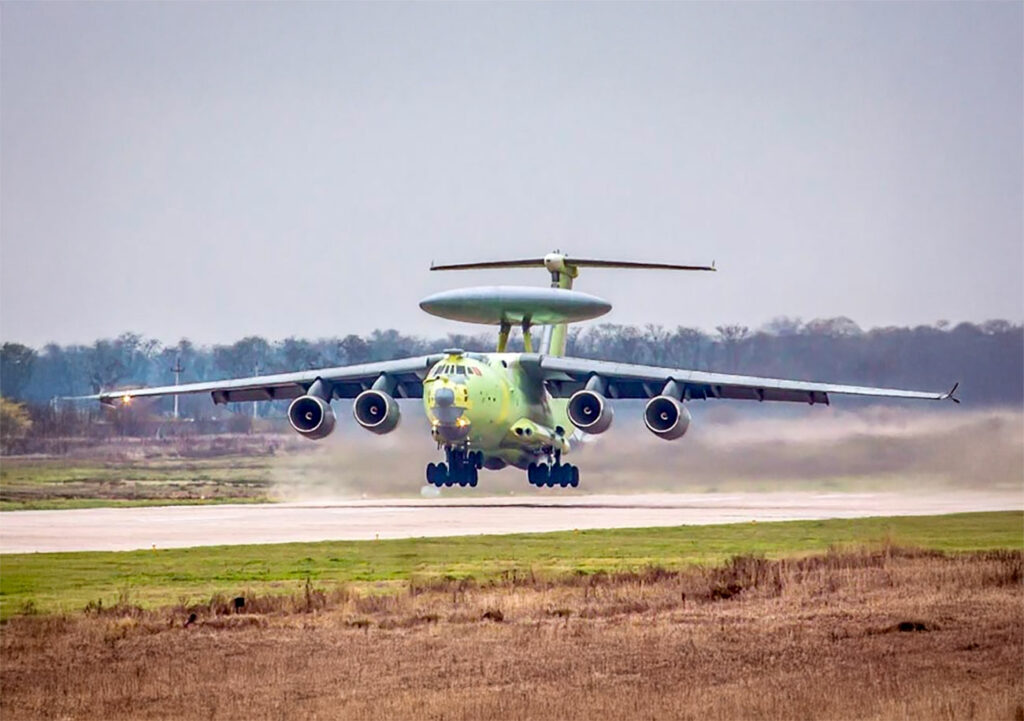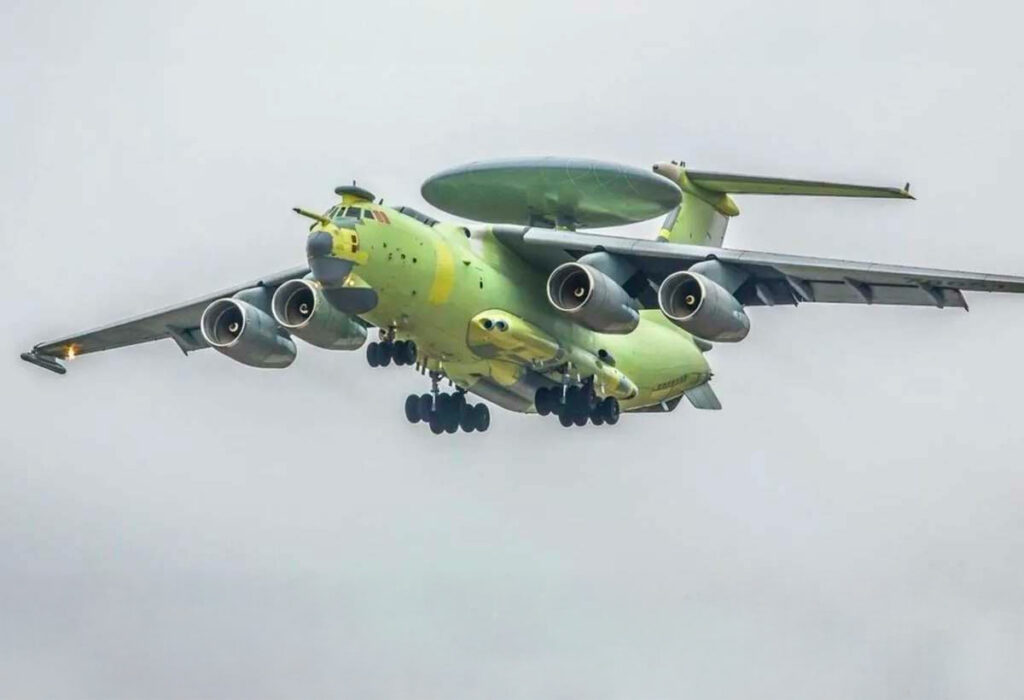The Beriev A-100 is a Russian airborne early warning and control (AEW&C) aircraft, developed to replace the A-50, featuring advanced radar systems.
The Beriev A-100 is a Russian airborne early warning and control (AEW&C) aircraft designed to succeed the A-50 in the Russian Aerospace Forces. Based on the Il-76MD-90A transport aircraft, it incorporates the new Vega Premier Active Phased Array Radar, enhancing target detection and tracking capabilities. The A-100 can detect aerial targets at distances up to 650 kilometers (approximately 400 miles) and maritime targets up to 400 kilometers (about 250 miles). Its design includes a rotating radar dome mounted on two struts above the fuselage, similar to its predecessor. The aircraft is powered by four Aviadvigatel PS-90A-76 turbofan engines, each producing 142 kN (approximately 32,000 lbf) of thrust, allowing a maximum speed of 900 km/h (around 559 mph) and a range of 7,500 kilometers (about 4,660 miles). The A-100 first flew on November 18, 2017, and is expected to enter service in the near future.
History of Development
In the early 2000s, the Russian military recognized the need to modernize its AEW&C fleet. The existing Beriev A-50 aircraft, introduced in the 1980s, were becoming outdated in the face of new stealth technologies and advanced electronic warfare systems. To address these challenges, the development of a new aircraft, designated as the A-100, was initiated.
The program officially began in 2006 when the Vega Radio Engineering Corporation signed a development contract to create a new radar system for the aircraft. The objective was to develop an AEW&C platform capable of detecting and tracking modern stealth aircraft and providing enhanced command and control capabilities. The A-100 was to be based on the Il-76MD-90A (Il-476) transport aircraft, an updated version of the Il-76 with improved engines and avionics.
The choice of the Il-76MD-90A airframe provided several advantages. Its increased payload capacity and range, along with the reliability proven over decades of service, made it a suitable platform for the sophisticated radar and electronic systems planned for the A-100. Additionally, using an existing airframe would potentially reduce development time and costs.
The A-100’s design includes the new Vega Premier Active Phased Array Radar housed in a rotating dome above the fuselage. This radar system offers electronic steering in elevation, while azimuth scanning is achieved through the rotation of the dome. The radar is capable of rotating once every five seconds, enhancing its ability to track fast-moving targets.
The first prototype of the A-100, converted from the third Il-76MD-90A airframe, was completed in 2014. After initial flight tests as a standard transport aircraft, it was transferred to the Beriev facility in Taganrog for conversion into the A-100 configuration. The aircraft underwent extensive modifications, including the installation of the radar dome, additional antennas, and mission systems.
The A-100 conducted its maiden flight on November 18, 2017. This flight marked a significant milestone in the program, demonstrating the airworthiness of the modified airframe and the integration of the new systems. Following the first flight, the aircraft entered a period of testing and evaluation to validate its performance and capabilities.
The development of the A-100 has faced several challenges, including delays attributed to Western sanctions impacting the availability of certain technologies and components. These sanctions have necessitated adjustments in the supply chain and the development of alternative solutions, contributing to the postponement of the aircraft’s entry into service.
As of early 2025, the A-100 remains in the testing phase, with plans for it to enter service in the near future. It is expected to enhance the Russian Aerospace Forces’ ability to conduct air surveillance, target detection, and command and control operations, ensuring the country’s air defense capabilities remain robust in the face of evolving threats.

Design of the Beriev A-100 (Premiere)
The Beriev A-100 is designed as a modern airborne early warning and control aircraft, building upon the legacy of its predecessor, the A-50. Its design incorporates several enhancements to improve performance, detection capabilities, and operational efficiency.
Airframe and Dimensions:
The A-100 is based on the Il-76MD-90A airframe, a modernized version of the Il-76 transport aircraft. The aircraft has a length of 46.6 meters (152.9 feet), a wingspan of 50.5 meters (165.7 feet), and a height of 14.76 meters (48.4 feet). The wing area is approximately 300 square meters (3,230 square feet). The maximum takeoff weight (MTOW) is around 195,000 kilograms (429,900 pounds).
Radar System:
A key feature of the A-100 is its radar system. The aircraft is equipped with the Vega Premier Active Phased Array Radar, housed in a rotating dome mounted on two struts above the fuselage. This radar provides electronic steering in elevation, while azimuth scanning is achieved through the rotation of the dome, which completes a full rotation every five seconds. This rapid rotation enhances the radar’s ability to track fast-moving targets. The radar can detect aerial targets at distances up to 650 kilometers (approximately 400 miles) and maritime targets up to 400 kilometers (about 250 miles). Its ability to detect and track multiple targets simultaneously provides a significant advantage in operational scenarios.
Engines and Powerplant:
The A-100 is powered by four Aviadvigatel PS-90A-76 turbofan engines, each delivering 142 kN (32,000 lbf) of thrust. These engines offer improved fuel efficiency and reliability compared to the older D-30KP engines used in the A-50. This enhancement contributes to the aircraft’s extended operational range and endurance.
Cockpit and Avionics:
The cockpit of the A-100 features modernized avionics, including digital displays and advanced navigation systems. This ensures enhanced situational awareness for the flight crew and enables more precise mission planning and execution. The mission systems include state-of-the-art communication equipment, allowing seamless coordination with other military units and assets.
Operational Capabilities:
The A-100’s operational capabilities include early warning, target detection, and airborne command and control. Its radar can identify stealth aircraft, ballistic missiles, and surface targets, making it a versatile asset for modern warfare. The aircraft also functions as a command center, enabling coordinated responses to aerial and ground-based threats.
Advantages and Limitations:
While the A-100 offers significant improvements in radar technology and operational range, its reliance on large and visible components, such as the rotating radar dome, could make it vulnerable to enemy detection and targeting. However, its advanced electronic warfare systems are designed to mitigate these risks.
Performance of the Beriev A-100 (Premiere)
The performance of the Beriev A-100 highlights its capabilities as a modern AEW&C aircraft. Below is an in-depth analysis of its specifications:
Speed and Altitude:
The A-100 has a maximum speed of 900 km/h (559 mph) and a cruising speed of 750 km/h (466 mph). It can operate at altitudes of up to 12,000 meters (39,370 feet), allowing it to effectively monitor large areas and provide strategic surveillance.
Range and Endurance:
The aircraft has a maximum range of 7,500 kilometers (4,660 miles) and can remain airborne for up to 10 hours without refueling. This endurance is crucial for extended missions, particularly in remote areas or during prolonged conflicts.
Radar Detection Capabilities:
The Vega Premier radar system can detect up to 300 targets simultaneously, including low-visibility and high-speed objects. Its long detection range of 650 kilometers (400 miles) for aerial targets and 400 kilometers (250 miles) for maritime targets ensures comprehensive situational awareness.
Comparison with Competitors:
Compared to similar aircraft like the American E-3 Sentry and the Chinese KJ-500, the A-100 offers competitive capabilities. While the E-3 has a comparable range and radar performance, the A-100 benefits from newer radar technology. However, the A-100’s relatively larger size and visibility may be a drawback compared to the smaller and stealthier KJ-500.
Payload and Crew:
The A-100 can accommodate a crew of 15-20 personnel, including radar operators, mission controllers, and maintenance staff. Its payload includes sophisticated electronic warfare equipment, communication systems, and additional fuel tanks for extended operations.
Drawbacks:
Despite its advanced features, the A-100 faces challenges such as dependency on a large radar dome, which can limit stealth. Additionally, delays in its development and the impact of sanctions have slowed its integration into active service.
Variants of the Beriev A-100 (Premiere)
The Beriev A-100 program includes potential variants designed to meet specific operational requirements:
- A-100 Standard Model:
The primary variant equipped with the Vega Premier radar system, designed for early warning, surveillance, and command roles. - A-100U (Upgraded):
A proposed variant featuring enhanced electronic warfare systems and upgraded avionics. This version is aimed at improving the aircraft’s survivability in contested airspaces. - A-100 Export Version:
A potential export variant tailored to the requirements of allied nations. Details about this variant remain limited, as no confirmed exports have occurred.
Each variant focuses on addressing specific mission profiles while retaining the core capabilities of the A-100 platform.

Military Use and Combat
The Beriev A-100 is designed primarily for strategic roles, including early warning, target tracking, and command and control in military operations. Its role in modern conflicts emphasizes its strategic value:
Armament and Defense Systems:
The A-100 is not armed with conventional weaponry, as its primary function is reconnaissance and coordination. However, it is equipped with advanced electronic warfare systems capable of disrupting enemy communications and radar.
Operational Deployment:
As of now, the A-100 has not been deployed in active combat. It is undergoing testing and evaluation, with plans for integration into the Russian Aerospace Forces. Once operational, it will replace the aging A-50 fleet and enhance Russia’s air defense capabilities.
Comparative Analysis:
In terms of operational roles, the A-100 competes with platforms like the American E-3 Sentry and the Chinese KJ-2000. While each aircraft has unique strengths, the A-100’s modern radar technology positions it as a formidable competitor.
Export Potential:
Despite its advanced features, the A-100 has not yet been sold to foreign nations. Factors such as geopolitical constraints and the availability of alternatives may influence its export prospects.
Future Prospects:
The A-100 is expected to play a pivotal role in Russia’s military strategy, particularly in regions requiring extensive surveillance. Its integration will likely improve the effectiveness of joint operations and enhance air defense networks.
The Beriev A-100 is a significant advancement in airborne early warning and control technology. Its modern radar system, extended range, and advanced avionics provide robust capabilities for strategic surveillance and command roles. While development delays and operational challenges persist, the A-100 represents a critical step forward in addressing contemporary military needs.
Back to the Spy Planes section.